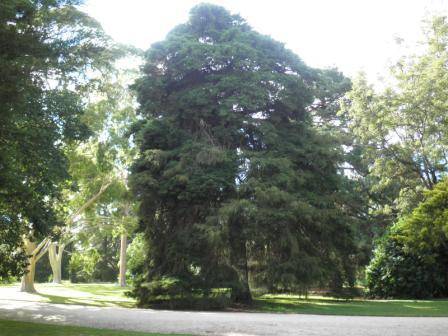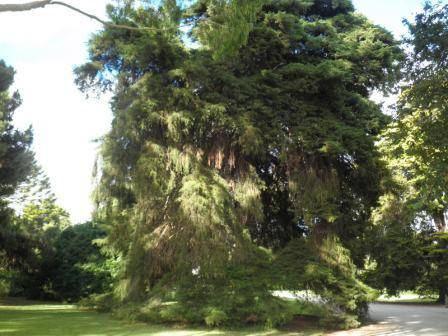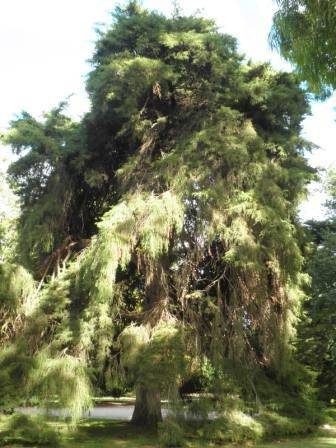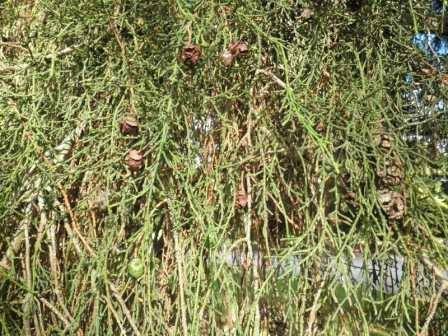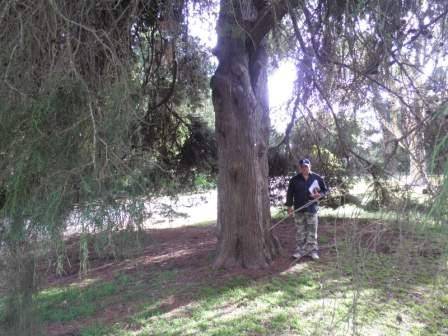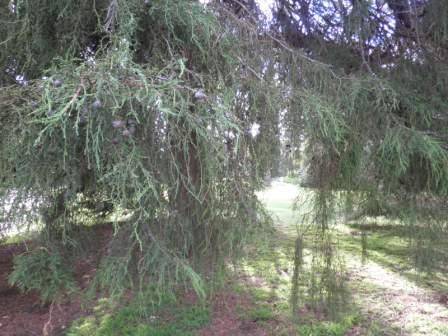| Back to search results » | Back to search page » |
|
Hesperocyparis macrocarpa 'Filipendula'
Statement of Significance
What is significant?
Horticultural value
Contribution to landscape of historic garden
Rare or localised
Outstanding size
Aesthetic significance
Curious growth form
Historical value
Outstanding example of species
This Weeping Monterey Cypress (Hesperocyparis macrocarpa 'Filipendula'), located along the Main Carriage Drive from the historic Gatehouse of Werribee Park Mansion,represents the extreme genetic and botanical variability of the Monterey Cypress species. This late nineteenth century specimen is very rare and not propagated in today's nursery industry. It has high genetic and propagation stock potential. This cypress specimen was selected and planted circa 1877 by the gardeners employed by Thomas Chirnside at Werribee Park. It is typical of the type of foliage and architectural form that nineteenth century garden enthusiasts with large rural estates collected and introduced to make their new homeland feel more "European." The Chirnside Family's contribution to Victoria's pastoral and agricultural growth is notable as leaders and pioneers of the colony's pastoral industry. Their vast land holdings in Victoria, New South Wales, South Australia and Queensland made them one of the wealthiest families in the colony. The grandeur of their influence and wealth is reflected in their opulent Roman Renaissance Revival style mansion at Werribee Park and its stately garden.
This Weeping Monterey Cypress (Hesperocyparis macrocarpa 'Filipendula') makes a significant aesthetic contribution to the immediate landscape of Werribee Park Mansion. It is very rare and this may be one of the best specimens in the State of Victoria from the nineteenth century. This specimen's height, uniform canopy spread and girth are notable. It has developed on a tall single leader trunk and weeps its foliage towards the ground. Its unique growth habit distinguishes it from its species and any other species cultivars growing in the garden.
Contribution to landscape of historic garden
Rare or localised
Outstanding size
Aesthetic significance
Curious growth form
Historical value
Outstanding example of species
This Weeping Monterey Cypress (Hesperocyparis macrocarpa 'Filipendula'), located along the Main Carriage Drive from the historic Gatehouse of Werribee Park Mansion,represents the extreme genetic and botanical variability of the Monterey Cypress species. This late nineteenth century specimen is very rare and not propagated in today's nursery industry. It has high genetic and propagation stock potential. This cypress specimen was selected and planted circa 1877 by the gardeners employed by Thomas Chirnside at Werribee Park. It is typical of the type of foliage and architectural form that nineteenth century garden enthusiasts with large rural estates collected and introduced to make their new homeland feel more "European." The Chirnside Family's contribution to Victoria's pastoral and agricultural growth is notable as leaders and pioneers of the colony's pastoral industry. Their vast land holdings in Victoria, New South Wales, South Australia and Queensland made them one of the wealthiest families in the colony. The grandeur of their influence and wealth is reflected in their opulent Roman Renaissance Revival style mansion at Werribee Park and its stately garden.
This Weeping Monterey Cypress (Hesperocyparis macrocarpa 'Filipendula') makes a significant aesthetic contribution to the immediate landscape of Werribee Park Mansion. It is very rare and this may be one of the best specimens in the State of Victoria from the nineteenth century. This specimen's height, uniform canopy spread and girth are notable. It has developed on a tall single leader trunk and weeps its foliage towards the ground. Its unique growth habit distinguishes it from its species and any other species cultivars growing in the garden.
Measurements: 12/02/2012
Spread (m) : 16.0
Girth (m): 2.9 at 1.4 above ground level
Height(m): 20.2
Estimated Age (yrs): 135
Condition: Excellent
Measurements: 08/12/2022
Spread (m) : N-S 13.0, E-W 12.2
Girth (m): 2.95
Height(m): 21.5
Estimated Age (yrs): 145
Lat/long: -37.9292938, 144.6714476
Condition: Excellent
Spread (m) : 16.0
Girth (m): 2.9 at 1.4 above ground level
Height(m): 20.2
Estimated Age (yrs): 135
Condition: Excellent
Measurements: 08/12/2022
Spread (m) : N-S 13.0, E-W 12.2
Girth (m): 2.95
Height(m): 21.5
Estimated Age (yrs): 145
Lat/long: -37.9292938, 144.6714476
Condition: Excellent
Access: Unrestricted
Classified: 28/05/2012
Classified: 28/05/2012
How is it significant?
Horticultural value
Contribution to landscape of historic garden
Rare or localised
Outstanding size
Aesthetic significance
Curious growth form
Historical value
Outstanding example of species
This Weeping Monterey Cypress (Hesperocyparis macrocarpa 'Filipendula'), located along the Main Carriage Drive from the historic Gatehouse of Werribee Park Mansion,represents the extreme genetic and botanical variability of the Monterey Cypress species. This late nineteenth century specimen is very rare and not propagated in today's nursery industry. It has high genetic and propagation stock potential. This cypress specimen was selected and planted circa 1877 by the gardeners employed by Thomas Chirnside at Werribee Park. It is typical of the type of foliage and architectural form that nineteenth century garden enthusiasts with large rural estates collected and introduced to make their new homeland feel more "European." The Chirnside Family's contribution to Victoria's pastoral and agricultural growth is notable as leaders and pioneers of the colony's pastoral industry. Their vast land holdings in Victoria, New South Wales, South Australia and Queensland made them one of the wealthiest families in the colony. The grandeur of their influence and wealth is reflected in their opulent Roman Renaissance Revival style mansion at Werribee Park and its stately garden.
This Weeping Monterey Cypress (Hesperocyparis macrocarpa 'Filipendula') makes a significant aesthetic contribution to the immediate landscape of Werribee Park Mansion. It is very rare and this may be one of the best specimens in the State of Victoria from the nineteenth century. This specimen's height, uniform canopy spread and girth are notable. It has developed on a tall single leader trunk and weeps its foliage towards the ground. Its unique growth habit distinguishes it from its species and any other species cultivars growing in the garden.
Contribution to landscape of historic garden
Rare or localised
Outstanding size
Aesthetic significance
Curious growth form
Historical value
Outstanding example of species
This Weeping Monterey Cypress (Hesperocyparis macrocarpa 'Filipendula'), located along the Main Carriage Drive from the historic Gatehouse of Werribee Park Mansion,represents the extreme genetic and botanical variability of the Monterey Cypress species. This late nineteenth century specimen is very rare and not propagated in today's nursery industry. It has high genetic and propagation stock potential. This cypress specimen was selected and planted circa 1877 by the gardeners employed by Thomas Chirnside at Werribee Park. It is typical of the type of foliage and architectural form that nineteenth century garden enthusiasts with large rural estates collected and introduced to make their new homeland feel more "European." The Chirnside Family's contribution to Victoria's pastoral and agricultural growth is notable as leaders and pioneers of the colony's pastoral industry. Their vast land holdings in Victoria, New South Wales, South Australia and Queensland made them one of the wealthiest families in the colony. The grandeur of their influence and wealth is reflected in their opulent Roman Renaissance Revival style mansion at Werribee Park and its stately garden.
This Weeping Monterey Cypress (Hesperocyparis macrocarpa 'Filipendula') makes a significant aesthetic contribution to the immediate landscape of Werribee Park Mansion. It is very rare and this may be one of the best specimens in the State of Victoria from the nineteenth century. This specimen's height, uniform canopy spread and girth are notable. It has developed on a tall single leader trunk and weeps its foliage towards the ground. Its unique growth habit distinguishes it from its species and any other species cultivars growing in the garden.
Measurements: 12/02/2012
Spread (m) : 16.0
Girth (m): 2.9 at 1.4 above ground level
Height(m): 20.2
Estimated Age (yrs): 135
Condition: Excellent
Measurements: 08/12/2022
Spread (m) : N-S 13.0, E-W 12.2
Girth (m): 2.95
Height(m): 21.5
Estimated Age (yrs): 145
Lat/long: -37.9292938, 144.6714476
Condition: Excellent
Spread (m) : 16.0
Girth (m): 2.9 at 1.4 above ground level
Height(m): 20.2
Estimated Age (yrs): 135
Condition: Excellent
Measurements: 08/12/2022
Spread (m) : N-S 13.0, E-W 12.2
Girth (m): 2.95
Height(m): 21.5
Estimated Age (yrs): 145
Lat/long: -37.9292938, 144.6714476
Condition: Excellent
Access: Unrestricted
Classified: 28/05/2012
Classified: 28/05/2012
Why is it significant?
Horticultural value
Contribution to landscape of historic garden
Rare or localised
Outstanding size
Aesthetic significance
Curious growth form
Historical value
Outstanding example of species
This Weeping Monterey Cypress (Hesperocyparis macrocarpa 'Filipendula'), located along the Main Carriage Drive from the historic Gatehouse of Werribee Park Mansion,represents the extreme genetic and botanical variability of the Monterey Cypress species. This late nineteenth century specimen is very rare and not propagated in today's nursery industry. It has high genetic and propagation stock potential. This cypress specimen was selected and planted circa 1877 by the gardeners employed by Thomas Chirnside at Werribee Park. It is typical of the type of foliage and architectural form that nineteenth century garden enthusiasts with large rural estates collected and introduced to make their new homeland feel more "European." The Chirnside Family's contribution to Victoria's pastoral and agricultural growth is notable as leaders and pioneers of the colony's pastoral industry. Their vast land holdings in Victoria, New South Wales, South Australia and Queensland made them one of the wealthiest families in the colony. The grandeur of their influence and wealth is reflected in their opulent Roman Renaissance Revival style mansion at Werribee Park and its stately garden.
This Weeping Monterey Cypress (Hesperocyparis macrocarpa 'Filipendula') makes a significant aesthetic contribution to the immediate landscape of Werribee Park Mansion. It is very rare and this may be one of the best specimens in the State of Victoria from the nineteenth century. This specimen's height, uniform canopy spread and girth are notable. It has developed on a tall single leader trunk and weeps its foliage towards the ground. Its unique growth habit distinguishes it from its species and any other species cultivars growing in the garden.
Contribution to landscape of historic garden
Rare or localised
Outstanding size
Aesthetic significance
Curious growth form
Historical value
Outstanding example of species
This Weeping Monterey Cypress (Hesperocyparis macrocarpa 'Filipendula'), located along the Main Carriage Drive from the historic Gatehouse of Werribee Park Mansion,represents the extreme genetic and botanical variability of the Monterey Cypress species. This late nineteenth century specimen is very rare and not propagated in today's nursery industry. It has high genetic and propagation stock potential. This cypress specimen was selected and planted circa 1877 by the gardeners employed by Thomas Chirnside at Werribee Park. It is typical of the type of foliage and architectural form that nineteenth century garden enthusiasts with large rural estates collected and introduced to make their new homeland feel more "European." The Chirnside Family's contribution to Victoria's pastoral and agricultural growth is notable as leaders and pioneers of the colony's pastoral industry. Their vast land holdings in Victoria, New South Wales, South Australia and Queensland made them one of the wealthiest families in the colony. The grandeur of their influence and wealth is reflected in their opulent Roman Renaissance Revival style mansion at Werribee Park and its stately garden.
This Weeping Monterey Cypress (Hesperocyparis macrocarpa 'Filipendula') makes a significant aesthetic contribution to the immediate landscape of Werribee Park Mansion. It is very rare and this may be one of the best specimens in the State of Victoria from the nineteenth century. This specimen's height, uniform canopy spread and girth are notable. It has developed on a tall single leader trunk and weeps its foliage towards the ground. Its unique growth habit distinguishes it from its species and any other species cultivars growing in the garden.
Measurements: 12/02/2012
Spread (m) : 16.0
Girth (m): 2.9 at 1.4 above ground level
Height(m): 20.2
Estimated Age (yrs): 135
Condition: Excellent
Measurements: 08/12/2022
Spread (m) : N-S 13.0, E-W 12.2
Girth (m): 2.95
Height(m): 21.5
Estimated Age (yrs): 145
Lat/long: -37.9292938, 144.6714476
Condition: Excellent
Spread (m) : 16.0
Girth (m): 2.9 at 1.4 above ground level
Height(m): 20.2
Estimated Age (yrs): 135
Condition: Excellent
Measurements: 08/12/2022
Spread (m) : N-S 13.0, E-W 12.2
Girth (m): 2.95
Height(m): 21.5
Estimated Age (yrs): 145
Lat/long: -37.9292938, 144.6714476
Condition: Excellent
Access: Unrestricted
Classified: 28/05/2012
Classified: 28/05/2012
Group
Parks, Gardens and Trees
Category
Tree


